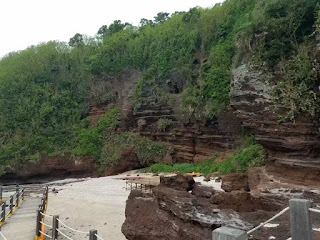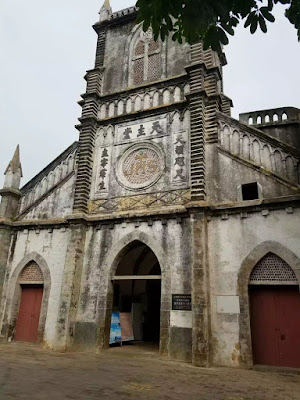Beihai (China)
Everything About Beihai
2017年6月7日星期三
2017年3月8日星期三
2016年1月16日星期六
The people on Weizhou Island, Part 1
Age: about 55.
Family: 7 members. Me, my wife, two sons, one daughter-in-law,
and two grandchildren. The elder son is married, and the younger son is not
married.
Career: Carpenter, fisherman, tofu business,
carrying things, selling pork. Now I earn my living as a motorized tricycle
driver.
Farming: We keep 20-30 chickens, and grow
soybeans and maize. Usually press oil from soybeans and feed corn to the
chickens.
One Day
Work: Get up at seven o'clock
in the morning, and have congee, fish and other simple dishes for breakfast.
Then drive my tricycle to find tourists. Usually have congee for lunch at a restaurant or my daughter's home at 1 p.m.
Head back home at around 6
p.m., and have steamed rice, pork, fish and soup for supper. In the evening,
watch TV with my family or chat with my neighbors. Usually go to bed at 11:30
p.m.
At home: Repair the house or
renovate the kitchen. In my leisure time, I usually go to a nearby store to play
mahjong or chat with villagers.
What do I fear
1. My family may have health problems.
2. I can't keep doing the driver job. Because many outsiders have come
to Weizhou to do this kind of job.
3. My younger son can't find a woman to be his wife.
4. Typhoon. It caused severe damage on the island last year.
5. Earthquake.
What do I want
1. The safety and health of my family.
2. Make some money so that we can tear down the old house to build a
new one. Because there is not enough room for the whole family.
3. My younger son gets married.2014年10月25日星期六
Tourist attraction④
Guantouling (冠头岭)
Guantouling
is a hilly area in the southwest of Beihai. It is located 8 km (5 miles) from
downtown, and its overall length is 3 km (1.9 miles). Guantouling got its name
because from a distance it looks like a hat. It consists of Wanglouling (望楼岭), Fengmenling (风门岭), Yajiling (丫髻岭), Tianmaling (天马岭), etc. Wanglouling is the main
peak, with an altitude of 120 meters (394 ft).
Now the
area has been designated as a National Forest Park, and it is covered with
dense forests of Casuarinaceae, Chinese red pine (马尾松, Pinus massoniana), Acacia confusa, etc. And it is an important stop
for migratory birds. During the migration season, various types of birds are
visible in the area, including raptors such as grey-faced buzzard, Japanese
sparrowhawk, Amur falcon, crested honey buzzard, etc.
◇
The Eight Views of Beihai "Guanfeng Lansheng" (冠峰览胜): There is a hill about 1.5 km south of Wanglouling. The top of the
hill has scenic views of the sea and surrounding area.
◇
"Haiya Shuangtao" (海涯双涛), one of
the Eight Views of Beihai, is a term for the waves and waving of pine trees
that can be seen on the southwestern coast.
◇
The Eight Views of Beihai "Longyan Chaoyin" (龙岩潮音): There was a sea cave with a height of 4 m and a depth of 11 m under
the cliffs on the southwestern coast. The cave was called Wanglongyan (王龙岩) because there was a local legend that a dragon lived in it. People
made the cave into an ancestral temple to Dragon King (龙王) and called it "Lianyang Gudong" (廉阳古洞). In the past there were many stones with a height of 2-3 m in the
beach in front of the cave. The stones made a thunderous sound when the waves
hit.
Many
young men and women come to visit Guantouling because it is said that the
ancestral temples here have miraculous powers.
◇
Shennongmiao (神农庙): The temple is located on
Maanling (马鞍岭) in the southeast of
Guantouling, and it enshrines Shennong, Tianfei (天妃, Mazu) and
Lu Ban (鲁班).
◇
Sanpomiao (三婆庙) and Dawangmiao (大王庙): The building is located on the southern tip of Guantouling, and it
enshrines several gods including Tianfei.
PS:
There is also a temple (built in 2009) named Pudusi (普度寺) in the south of Guantouling.
■ Bus routes: No. 6
Bus No. 6 (6路): 6:30~18:00, ¥2.00
Nanwan (南澫)
Nanwan
is a small fishing village near Guantouling. The population is 600-700, and
most of the residents make their living by fishing. The village was gradually
formed from the late Ming dynasty onwards. At that time it was under the
jurisdiction of Gulizhai (古里寨, a fortress built in the early
Ming dynasty), and was a place where people collected pearls. As more and more
people settled in the area, the village was named Nanwan which means there is
the sea to the south. The fishermen of Nanwan frequently visited the harbor
between Dijiao (地角) and Waisha (外沙), and they called the sea north of the harbor "Beimianhai" (北面海). Afterwards, the village formed near the harbor was called Beihai (北海).
Wudimiao
(武帝庙)
Wudimiao
(original name is Guandimiao (关帝庙)) is an ancestral temple beside
the road in the village. The temple was built in the period of the Kangxi
Emperor (康熙年间), and it was moved twice in the
period of the Daoguang (道光) and Tongzhi (同治) and then renovated twice, in 1907 and 1990. It enshrines Guan Yu (关羽), Guan Ping (关平), Zhou Cang (周仓) in the back hall, and enshrines Huaguang Dadi (华光大帝, Matian Jun (马天君), a defender of Taoism) and
Sanpopo (三婆婆, i.e. Mazu (妈祖)/Tianhou (天后)) in the rooms on both sides.
And there is a "Qifu" (祈福, pray for blessings) event
during the Yuanxiao Festival.
Qianjiang (乾江)
Qianjiang (old name is Qianti (乾体), which was called
"Kan lai" (勤礼) by
residents of the Beihai area) is a village southwest of Lianzhou Town (廉州镇) in Hepu
County (合浦县), and it has more than 2000
years of history. The area around Qianjiang was called Qiantigang (乾体港), and it
was a port of departure of the Maritime Silk Road. During the Western Han
dynasty, products like silk, tea leaves, porcelains were exported through the port to Southeast
Asia.
The
place is famous for dog meat dishes made by using a special recipe, and
therefore it is also called Dogmeat Street (狗肉街) by residents
of the Beihai area. Xiazhi (夏至) is the busiest time of year, because there is
a custom that people eat dog meat and lychees on Xiazhi in Hepu (合浦).
◇
Etymology: According to legend, the area was first settled by three
brothers of the Chen family. The eldest was Qiande (乾德) who made a lot of money in business, the second was Qianti (乾体) who
read a lot and gained an official position, the youngest was Qianjiang (乾江) who was
engaged in fishing and shipping. So, people named the village after the second brother who had
authority. And the main street of the village was called Qiande Dajie (乾德大街), and the nearby small river was called Qianjiang. The village
was renamed Qianjiang during liberation (1949).
◇
Kan lai po (勤礼婆) is a term for a woman of Qianjiang. From ancient times, the women of Qianjiang managed
the household by selling seafood, and the men studied to pass the imperial
examination. Every day the women carried seafood to the market of Lianzhou (廉州) to sell by using carrying
poles. People were impressed that they shouted to passers-by to move aside on
the way. And there are many stories that they united to fight against unfair
trading.
■ Bus routes: No. 10
Bus No. 10 (10路): 6:40~18:00, ¥3.50
Dijiao (地角)
Dijiao
is a fishing village in the northwest of Beihai. The village got its name
because it was formed in the protruding area of the coast. Most of the
residents believe in Erlang Shen (二郎神).
PS:
There is a female militia company (established in 1963) in Dijiao.
Dawanggong (大王宫)
The date of construction is unclear but is thought to
be in the Qing
dynasty. Dawanggong was demolished in 1987 and rebuilt on Dijiaoling (地角岭, a hill southwest
of the village) in 1989.
It enshrines gods
such as Erlang Shen, Jindian Dawang (金殿大王),
Zhengshi Furen (郑氏夫人). On the birthday of Erlang Shen, local residents hold a ceremony and
invite Cantonese opera
companies here.
◇
The legend: There was an old woman who lived in Dijiao. One day, the old
woman noticed that a big stone was following her while collecting seafood on
the beach. She said to the stone, "If you can help catch ten horseshoe
crabs, I will accept you as a god." Later that day, the old woman really
caught ten horseshoe crabs. So, she kept her promise and carried the stone and crabs
to the village
by carrying pole. The rope broke suddenly in a place and the stone became too
heavy to move. Shortly afterwards, the villagers heard of this and built an ancestral temple in that
place. The stone was worshiped as Jindian Dawang, and the old woman was honored
as Zhengshi Furen in the temple after her death.
Dijiao
Paotai (地角炮台)
After Feng
Zicai (冯子材, a native of Qinzhou (钦州)) defeated the French troops in the Zhennan Pass (镇南关, Friendship Pass) during the Sino-French War in 1885, Zongbing (总兵, a brigadier general) Liang Zhengyuan (梁正源) received
orders from the Qing government to build several artillery batteries in the
coastal area of Beihai. There were three artillery batteries on
Dijiaoling. In the Battle of South Guangxi (part of the Second Sino-Japanese
War) in November 1939,
the batteries on Dijiaoling were destroyed by gunfire from Japanese warships.
■ Bus routes: No. 2
Bus No. 2 (2路): 6:15~21:00, ¥1.50
订阅:
评论 (Atom)





























































